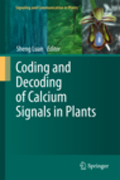
Plants cannot move away from their environments. As a result, all plants thathave survived to date have evolved sophisticated signaling mechanisms that allow them to perceive, respond, and adapt to constantly changing environmental conditions. Among the many cellular processes that respond to environmental changes, elevation of calcium levels is by far the most universal messenger thatmatches primary signals to cellular responses. Yet it remains unclear how calcium, a simple cation, translates so many different signals into distinct responses - how is the “specificity” of signal-response coupling encoded within the calcium changes?. This book will attempt to answer this question by describing the cellular and molecular mechanisms underlying the coding and decoding ofcalcium signals in plant cells. Describes the cellular and molecular mechanisms underlying coding and decoding of calcium signals in plant cells. With contributions by international experts. Provides a clear overview of the basics. INDICE: La Calcium, C’est La Vie. Calcium Signaling and Homesotasis in Nuclei. Calcium Signals in Pollen Tube Polar Growth. Calcium, Mechanical Signaling, and Tip Growth. Calcium Signals in The Control of Stomatal Movements. Calcium Channels in Algae and Higher Plants. Cyclic Nucleotide Gated Channels and The Generation of Ca2+ Signals. Annexins. Calcium-Dependent Proteins Kinases. Elucidation of Calcium Signaling Components and Networks. Decoding of Calcium Signal Through Calmodulin: Calmodulin-Binding Proteins in Plants. Decoding Calcium Signals by CBL-CIPK Network in Plants.
- ISBN: 978-3-642-20828-7
- Editorial: Springer Berlin Heidelberg
- Encuadernacion: Cartoné
- Páginas: 270
- Fecha Publicación: 01/08/2011
- Nº Volúmenes: 1
- Idioma: Inglés
